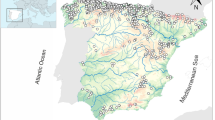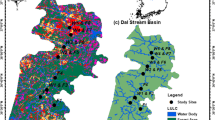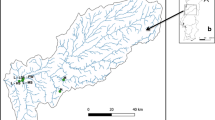Abstract
Contemporary large-scale river ecology is grounded on the existence of patterns in the distribution of aquatic communities, structured by prevailing abiotic conditions. Here, we investigated the existence of functional consistent associations of traits (i.e., traits appearing consistently together at different sites and the same river type) between different biological elements of the aquatic community, assuming that species traits confer them advantages for certain environmental conditions but also within the aquatic community. If this is true, these trait associations should be consistently found in water bodies with similar characteristics (river types), defining different types of ecosystem functioning. To test this, 79 least-disturbed sites, belonging to five well-defined Portuguese river types and covering the longitudinal river gradient were used: headwaters of semi-arid streams, mountainous streams and northern-Atlantic climate streams, middle reaches and lowland large rivers. For each river type, we analyzed the strongest associations (via the Bray–Curtis coefficient) between diatoms, benthic invertebrates and macrophytes and traits that could be relevant to their interactions (e.g., invertebrate trophic groups, mobility/fixation ability of diatoms, macrophyte affinity to water) against a priori predictions. The strongest associations of traits changed over the river continuum with an increase in their complexity (number of associations) from headwaters to middle reaches and a decrease in lowland large rivers. These changes were not related to total richness, which was similar for all river types and over the continuum (ca. 100 taxa). In the three types of headwaters, there were also clear differences in associations among aquatic elements. The importance of riparian trees in small streams was not as high as expected while instream macrophytes were more relevant than predicted. This study revealed the existence of predictable functional associations that could serve as a basis for the functional assessment of running waters.


Similar content being viewed by others
References
Aguiar FC, Ferreira MT, Pinto P (2002) Relative influence of environmental variables on macroinvertebrate assemblages from an Iberian basin. J N Am Benthol Soc 21:43–53
Aguiar FC, Cerdeira JO, Martins MJ, Ferreira MT (2013) Riparian forests of Southwest Europe: are functional trait and species composition assemblages constrained by environment? J Veg Sci 24:628–638
Aguiar F, Segurado P, Urbanič G, Cambra J, Chauvin C, Ciadamidaro S, Dörflinger G, Ferreira J, Germ M, Manolaki P, Minciardi MR, Munné A, Papastergiadou E, Ferreira MT (2014) Comparability of river quality assessment using macrophytes: a multi-step procedure to overcome biogeographical differences. Sci Total Environ 476(:):757–767
Allan JD (1983) Predator–prey relationships in streams. In: Barnes JR et al (eds) Ecology stream. Plenum Press, New York
Anderson C, Cabana G (2007) Estimating the trophic position of aquatic consumers in river food webs using stable nitrogen isotopes. Freshw Sci 26:273–285
Barnes C, Jennings S, Polunin NVC, Lancaster JE (2008) The importance of quantifying inherent variability when interpreting stable isotope field data. Oecologia 155:227–235
Besemer K, Singer G, Quince C, Bertuzzo E, Sloan W, Battin TJ (2013) Headwaters are critical reservoirs of microbial diversity for fluvial networks. Proc R Soc 280:20131760. doi:10.1098/rspb.2013.1760
Bornette G, Tabacchi E, Hupp C, Puijalon S, Rostan JC (2008) A model of plant strategies in fluvial hydrosystems. Freshw Biol 53(:):1692–1705
Boulton AJ, Boyero L, Covich AP, Dobson M, Lake S, Pearson R (2008) Are tropical streams ecologically different from temperate streams? In: Dudgeon D (Ed) Tropical stream ecology Chap. 9. Academic Press, London, pp 257–283
Bray JR, Curtis JT (1957) An ordination of upland forest communities of southern Wisconsin. Ecol Monogr 27:325–349
Bruder A, Schindler MH, Moretti MS, Gessner MO (2014) Litter decomposition in a temperate and a tropical stream: the effects of species mixing, litter quality and shredders. Freshw Biol 59:438–449
Chícharo MA, Chícharo L, Morais P (2006) Inter-annual differences of ichthyofauna structure of the Guadiana estuary and adjacent coastal area (SE Portugal/SW Spain): before and after Alqueva dam construction. Estuarine Coastal Shelf Sci 70:39–51
Clarke KR, Warwick RM (2001) Change in marine communities: an approach to statistical analysis and interpretation. PRIMER-E Ltd, Plymouth
Coat S, Monti D, Bouchon C, Lepoint G (2009) Trophic relationships in a tropical stream food web by stable isotope analysis. Freshw Biol 54(:):1028–1041
Comte J, del Giorgio PA (2011) Composition influences the pathway but not the outcome of the metabolic response of bacterioplankton to resource shifts. PLoS One 6:e25266
Corenblit D, Steiger J, Gurnell AM, Naiman RJ (2009) Plants intertwine fluvial landform dynamics with ecological succession and natural selection: a niche construction perspective for riparian systems. Global Ecol Biogeogr 18(:):507–520
Dangles O (2002) Functional plasticity of benthic macroinvertebrates: implications for trophic dynamics in acid streams. Can J Fish Aquat Sci 59(:):1–11
de Bello F, Lavorel S, Díaz S et al (2010) Towards an assessment of multiple ecosystem processes and services via functional traits. Biodivers Conserv 19:2873–2893
Dolph CL, Huff DD, Chizinski CJ, Vondracek B (2011) Implications of community concordance for assessing stream integrity at three nested spatial scales in Minnesota, U.S.A. Freshw Biol 56:1652–1669
Elosegi S, Sabater S (2013) Effects of hydromorphological impacts on river ecosystem functioning: a review and suggestions for assessing ecological impacts. Hydrobiologia 712:129–143
Esslemont G, Maher W, Ford P, Lawrence I (2007) Riparian plant material inputs to the Murray River, Australia: composition, reactivity, and role of nutrients. J Environ Qual 36(:):963–974
Feio MJ, Almeida SFP, Craveiro SC, Calado AJ (2007) Diatoms and macroinvertebrates provide consistent and complementary information on environmental quality. Fundam Appl Limnol/Archiv für Hydrobiol 168/3:247–258
Feio MJ, Aguiar FC, Almeida SFP, Ferreira MT (2012) AQUAFLORA: a predictive model based on diatoms and macrophytes for streams water quality assessment. Ecol Indic 18:586–598
Feio MJ, Aguiar FC, Almeida SFP, Ferreira J, Ferreira MT, Elias C, Serra SRS, Buffagni A, Cambra J, Chauvin C, Delmas F, Dörflinger G, Erba S, Flor N, Ferréol M, Germ M, Mancini L, Manolaki P, Marcheggiani S, Minciardi MR, Munné A, Papastergiadou E, Prat N, Puccinelli C, Rosebery J, Sabater S, Ciadamidaro S, Tornés E, Tziortzis I, Urbanic G, Vieira C (2014) Least disturbed conditions for European Mediterranean rivers. Sci Total Environ 476–477(:):745–756
Feminella JW, Hawkins CP (1995) Interactions between stream herbivores and periphyton: a quantitative analysis of past experiments. J N Am Benthol Soc 14:465–509
Fernandes MR, Aguiar FC, Pereira JM, Ferreira MT (2013) Spectral separability of riparian forests from small and medium-sized rivers across a latitudinal gradient using multispectral imagery. Int J Remote Sens 34(:):2375–2401
Franco JA, Rocha Afonso ML (2003) Nova Flora de Portugal, vol. 3 Juncaceae-Orchidaceae. Escolar Editora, Lisbon, p 198
Freimann R, Bürgmann H, Findlay SEG, Robinson CT (2013) Bacterial structures and ecosystem functions in glaciated floodplains: contemporary states and potential future shifts. ISME J 7:2361–2373
Friberg N, Jacobsen D (1994) Feeding plasticity of two detritivore-shredders. Freshw Biol 32:133–142
Gasith A, Resh VH (1999) Streams in Mediterranean climate regions: abiotic influencesand biotic responses to predictable seasonal events. Annu Rev Ecol Syst 30:51–81
Gette-Bouvarot M, Mermillod-Blondin F, Lemoine D, Delolme C, Danjean M, Etienne L, Volatier L (2015) The potential control of benthic biofilm growth by macrophytes—a mesocosm approach. Ecol Eng 75:178–186
Graça MAS (2001) The role of invertebrates on leaf litter decomposition in streams—a review. Int Rev Hydrobiol 86:383–393
Graça MAS, Cressa C (2010) Leaf quality of some tropical and temperate tree species as food resource for stream shredders. Int Rev Hydrobiol 95:27–41
Grubaugh JW, Wallace JB, Houston ES (1996) Longitudinal changes of macroinvertebrate communities along an Appalachian stream continuum. Can J Fish Aquat Sci 53:896–909
Hardy CM, Krull ES, Hartley DM, Olivier RL (2010) Carbon source accounting for fish using combined DNA and isotope analyses in a regular lowland river. Mol Ecol 19:197–212
INAG IP (2008a) Manual para a avaliação biológica da qualidade da água em sistemas fluviais segundo a Directiva Quadro da Água. Protocolo de amostragem e análise para os macroinvertebrados bentónicos. Ministério do Ambiente, Ordenamento do Território e do Desenvolvimento Regional. Instituto da Água, I.P.
INAG IP (2008b) Manual para a avaliação biológica da qualidade da água em sistemas fluviais segundo a Directiva Quadro da Água. Protocolo de amostragem e análise para fitobentos-diatomáceas. Ministério do Ambiente, Ordenamento do Território e do Desenvolvimento Regional. Instituto da Água, I.P.
INAG IP (2008c) Manual para a avaliação biológica da qualidade da água em sistemas fluviais segundo a Directiva Quadro da Água. Protocolo de amostragem e análise para os macrófitos. Ministério do Ambiente, Ordenamento do Território e do Desenvolvimento Regional. Instituto da Água, I.P.
Jackson DA (1993) Multivariate analysis of benthic invertebrate communities: the implication of choosing particular data standardizations, measures of association, and ordination methods. Hydrobiologia 268:9–26
Jacobsen D (1993) Trichopteran larvae as consumers of submerged angiosperms in running waters. Oikos 67:379–383
Jacobsen D, Sandjensen K (2006) Variability of invertebrate herbivory on the submerged macrophyte Potamogeton perfoliatus. Freshw Biol 34:357–365
Janauer GA, Schmidt-Mumm U, Reckendorfer W (2013) Ecohydraulics and aquatic macrophytes: assessing the relationship in river floodplains. In: Maddock I, Harby A, Kemp P, Wood P (eds) Ecohydraulics: an integrated approach. Wiley, Chichester
Johnson RK, Hering D (2009) Response of taxonomic groups in streams to gradients in resource and habitat characteristics. J Appl Ecol 46:175–186
Johnson RK, Furse MT, Hering D, Sandin L (2007) Ecological relationships between stream communities and spatial scale: implications for designing catchment-level monitoring programmes. Freshw Biol 52:939–958
Junk WJ, Bayley PB, Sparks RE (1989) The Flood pulse concept in river floodplain systems. Can Spec Publ Fish Aquat Sci 106:110–127
Lange K, Liess A, Piggott JJ, Townsend CR, Matthaei CD (2011) Light, nutrients and grazing interact to determine stream diatom community composition and functional group structure. Freshw Biol 56:264–278
Lau DCP, Leung KMY, Dudgeon D (2008) What does stable isotope analysis reveal about trophic relationships and the relative importance of allochthonous and autochthonous resources in tropical streams? A synthetic study from Hong Kong. Freshw Biol 54:127–141
Lite SJ, Bagstad KJ, Stromberg JC (2005) Riparian plant species richness along lateral and longitudinal gradients of water stress and flood disturbance, San Pedro River, Arizona, USA. J Arid Environ 63:785–813
Madritch MD, Cardinale BJ (2007) Impacts of tree species diversity on litter decomposition in northern temperate forests of Wisconsin, USA: a multi-site experiment along a latitudinal gradient. Plant Soil 292(:):147–159
Marchant R, Mitchell P, Norris RH (1984) Distribution of benthic invertebrates along a disturbed section of the LaTrobe River, Victoria: an analysis based on numerical classification. Aust J Mar Freshwat Res 35:355–374
Mihuc TB (1997) The functional trophic role of lotic primary consumers: generalist versus specialist strategies. Freshw Biol 37:455–462
Naiman RJ, Melillo JM, Lock MA, Ford TE, Reice SR (1987) Longitudinal patterns of ecosystem processes and community structure in a subartic river continuum. Ecology 68:1139–1156
Newman RM (1991) Herbivory and detritivory on freshwater macrophytes by invertebrates: a review. J N Am Benthol Soc 10:89–114
Novais MH, Morais MM, Rosado J, Dias LS, Hoffmann L, Ector L (2014) Diatoms in temporary and permanent watercourses in Southern Europe (Portugal). River Res Appl 30:1216–1232
Ollinger SV (2011) Sources of variability in canopy reflectance and the convergent properties of plants. New Phytol 189:375–394
Paavola R, Muotka T, Virtanen R, Heino J, Kreivi P (2003) Are biological classifications of headwater streams concordant across multiple taxonomic groups? Freshw Biol 48:1912–1923
Paavola R, Muotka T, Virtanen R, Heino J, Jackson D, Maki-Petays A (2006) Spatial scale affects community concordance among fishes, benthic macroinvertebrates, and bryophytes in streams. Ecol Appl 16:368–379
Passy SI (2007) Diatom ecological guilds display distinct and predictable behavior along nutrient and disturbance gradients in running waters. Aquat Bot 86:171–178
Peckarsky BL (2006) Predator-prey interactions. In: Hauer R, Lamberti G (eds) Methods in stream ecology, 2nd edn. Academic Press, New York
Poff NL, Olden JD, Vieira NKM, Finn DS, Simmons MP, Kondratieff BC (2006) Functional trait niches of North American lotic insects: trait-based ecological applications in light of phylogenetic relationships. J North Am Benthol Soc 25:730–755
Renöfält BM, Nilsson C, Jansson R (2005) Spatial and temporal patterns of species richness in a riparian landscape. J Biogeogr 32:2015–2037
Reynoldson TB, Norris RH, Resh VH, Day KE, Rosenberg DM (1997) The reference condition: a comparison of multimetric and multivariate approaches to assess water-quality impairment using benthic macroinvertebrates. J N Am Benthol Soc 16:833–852
Rimet F, Bouchez A (2012) Life-forms, cell-sizes and ecological guilds of diatoms in European rivers. Knowl Manage Aquat Ecosyst 406:1–14
Sand-Jensen K, Borum J (1991) Interactions among phytoplankton, periphyton, and macrophytes in temperate freshwaters and estuaries. Aquat Bot 41:137–175
Sanpera-Calbet I, Lecerf A, Chauvet E (2009) Leaf diversity influences in-stream litter decomposition through effects on shredders. Freshw Biol 54:1671–1682
Sculthorpe CD (1967) The biology of aquatic vascular plants. Edward Arnold Publishers, London
Sedell JR, Richey JE, Swanson FJ (1989) The river continumm concept: a basis for the expected ecosystem behavior of very large rivers? 49–55 (Ed: DP Didge). In: Proceedings Of the International Large River symposium. Can. Spec. Publ. Fish. Aquat. Sci. 106:49–55
Serra SRQ, Cobo F, Graça MAS, Dolédec S, Feio MJ (2016) Synthesising the trait information of European Chironomidae (Insecta: Diptera): towards a new database. Ecol Indic 61:282–292
Southwood TRE (1977) Habitat, the templet for ecological strategies. J Anim Ecol 46:337–365
Statzner B, Higler B (1985) Questions and comments on the river continuum concept. Can J Fish Aquat Sci 42:1038–1044
Steinman AD (1996) Effects of grazers on freshwater benthic algae. In: Stevenson RJ, Bothwell ML, Lowe RL (eds) Algal ecology: freshwater benthic ecosystems. Academic Press, San Diego, pp 341–373
Stenroth K, Bohman I, Herrmann J (2010) The importance of terrestrial resource subsidies for shredders in open-canopy streams revealed by stable isotope analysis. Freshw Biol 56:470–480
Stoddard JL, Larsen DP, Hawkins CP, Johnson RK, Norris RH (2006) Setting expectations for the ecological condition of streams: the concept of reference condition. Ecol Appl 16:1267–1276
Swan CM, Palmer MA (2006) Preferential feeding by an aquatic consumer mediates non-additive decomposition of speciose leaf litter. Oecologia 149:107–114
Székely AJ, Berga M, Langenheder S (2013) Mechanisms determining the fate of dispersed bacterial communities in new environments. ISME J 7:61–71
Tachet H, Richoux P, Bournaud M, Usseglio-Polatera P (2010) Invertébrés d’eau douce, Nouvelle edition. Centre National de la Recherche Scientifique Press, Paris
Tilman D, Knops J, Wedin D, Reich P, Ritchie M, Siemann E (1997) The influence of functional diversity and composition on ecosystem processes. Science 277:1300–1302
Tockner K, Malard F, Ward JV (2000) An extension of the flood pulse concept. Hydrol Process 14:2861–2883
Tornés E, Acuña V, Dahm CN, Sabater S (2015) Flood disturbance effects on benthic diatom assemblage structure in a semiarid river network. J Phycol 51:133–143
Townsend CR, Doledec S, Scarsbrook MR (1997) Species traits in relation to temporal and spatial heterogeneity in streams: a test of habitat templet theory. Freshw Biol 37:367–387
Vannote RL, Minshall GW, Cummins KW, Sedell JR, Cushing CE (1980) The river continuum concept. Can J Fish Aquat Sci 37:130–137
Watson A, Barmuta L (2011) Feeding-preference trials confirm unexpected stable isotope analysis results: freshwater macroinvertebrates do consume macrophytes. Mar Freshw Res 62:1248–1257
Winterbourn MJ, Rounick JS, Cowie B (1981) Are New Zealand stream ecosystems really different? NZ J Mar Freshw Res 15:321–328
Woodward G, Bonada N, Brown LE, Death RG, Durance I, Gray C, Hladyz S, Ledger ME, Milner AM, Ormerod SJ, Thompson RM, Pawar S (2016) The effects of climatic fluctuations and extreme events on running water ecosystems. Phil Trans R Soc B 371:20150274
Acknowledgements
We acknowledge the Fundação para a Ciência e a Tecnologia (Portugal)—FCT, for financial support through the strategic project UID/MAR/04292/2013 granted to MARE and to Centro de Estudos Florestais, Universidade de Lisboa, within UID/AGR/00239/2013; to the MARE-Marine and Environmental Sciences Centre and University of Coimbra; and to the Biology Department and Geobiotec research centre at the University of Aveiro. FCA received funding by the FCT post-doctoral Grant SFRH/BPD/112417/2015.
Author information
Authors and Affiliations
Corresponding author
Electronic supplementary material
Below is the link to the electronic supplementary material.
Rights and permissions
About this article
Cite this article
Feio, M.J., Almeida, S.F.P. & Aguiar, F.C. Functional associations between microalgae, macrophytes and invertebrates distinguish river types. Aquat Sci 79, 909–923 (2017). https://doi.org/10.1007/s00027-017-0541-4
Received:
Accepted:
Published:
Issue Date:
DOI: https://doi.org/10.1007/s00027-017-0541-4




